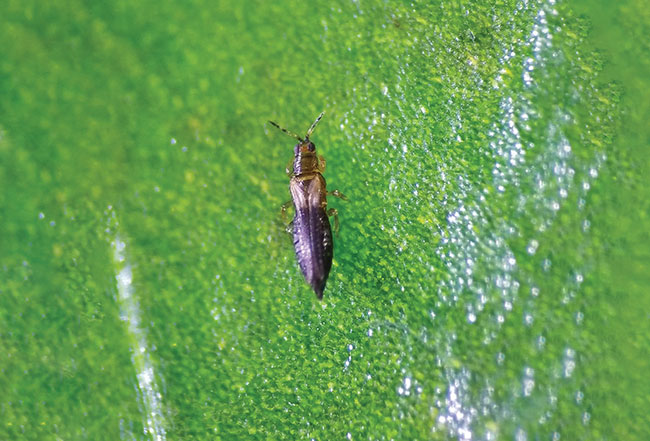
Features
Thrips parvispinus Q & A
A quick update on monitoring this pest and resources for growers
February 16, 2024 By GREENHOUSE CANADA
 According to Dr. Fry, Thrips paravaspinus lay eggs in the bracts of flowers so flowers are also damaged and not just the leaves (this is important to note to distinguish from broad mite damage, as broad mites do not usually damage flowers).
Photo: A. Summerfield, Vineland
According to Dr. Fry, Thrips paravaspinus lay eggs in the bracts of flowers so flowers are also damaged and not just the leaves (this is important to note to distinguish from broad mite damage, as broad mites do not usually damage flowers).
Photo: A. Summerfield, Vineland Greenhouse Canada recently reached out to entomologist Dr. Ken Fry, of Olds College in Alberta, to share some up-to-date insights on one of the newest Thrips species making a pest of themselves in Canadian greenhouses. Here’s what he had to say about this unwanted intruder:
1.What are the primary challenges associated with studying and controlling Thrips parvispinus
Dr. Ken Fry: The damage is similar to broad mite damage so it can easily be misdiagnosed. They are very small so may be missed when conducting visual inspections. The larvae prefer young rolled up leaves (newly emerging) therefore not easily detected. This species does lay its eggs in the bracts of flowers so flowers are also damaged and not just the leaves (this is important to note to distinguish from broad mite damage, as broad mites do not usually damage flowers). Another aspect of this species that is concerning is tropical or ornamental plants with a single growing point are worst affected. The feeding can dead-head the plant.
2. Are there specific environmental factors that contribute to the population dynamics of Thrips parvispinus?
Fry: [Thrips parvispinus] is not much different than the Western flower thrips in terms of response to environmental conditions.
3. Can you recommend any monitoring or surveillance techniques that growers can use to detect Thrips parvispinus early in their crops?
Fry: Monitor vegetative foliage before flowers develop in order to be proactive in managing the thrips. Plant tapping (tapping foliage over a white sheet of paper) is well correlated with foliar damage versus adult counts in flowers. This thrips is usually found to be patchy in its distribution. Plant tapping has been found to be more reliable than using sticky cards. Monitoring should be conducted weekly as the developmental time is short (approx. three weeks).
4. Are there any practices or crop management strategies that can help reduce the risk of Thrips parvispinus infestations?
Fry: Biosecurity is the first step. Quarantine all new plant material coming in to detect contamination and prevent spread in the production area. Communicate with your suppliers about possible risk of contamination, which biocontrols or pesticides they have used so you can integrate your practices accordingly (i.e. pesticide mode of action rotation sequence). Cuttings can be dipped in soaps, oils and Beauveria bassiana. Check the label for approved crops and rates. The Ontario Ministry of Agriculture, Food and Rural Affairs (OMAFRA) website has good information on preventative dipping. Mass trapping of adults using yellow sticky cards has been shown to be effective in ornamental crops. The adults are very active fliers and readily go to sticky cards. There are several biological control agents that have been shown to be effective against this Thrips, including Orius spp., green and brown lacewings, and Amblyseius swirskii. Anystis is also being evaluated for efficacy against the pepper thrips. For pesticide use and this species, please see the Greenhouse Canada article in the August 2023 issue by Dr. Sarah Jandricic.
5. What is the current state of research on Thrips parvispinus, and are there any recent developments or findings that are particularly relevant?
Fry: I know that there are people in Florida testing various pesticides (see the IR4 thrips efficacy update (https://www.ir4project.org/ehc/researchsummary/efficacy/thrips-efficacy-2022/). Dr. Rose Buitenhuis at Vineland Research and Innovation Centre is also doing some work on monitoring, as is Dr. Sarah Jandricic, from the Ontario Ministry of Agriculture, Food and Rural Affairs (OMAFRA).
Print this page